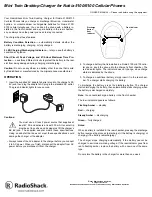
121
Safety Guidelines
of exposure to a cancer-causing agent
and the time tumors develop - if they
do- may be many, many years. The
interpretation of epidemiological studies
is hampered by difficulties in measuring
actual RF exposure during day-to-day
use of wireless phones. Many factors
affect this measurement, such as the
angle at which the phone is held, or
which model of phone is used.
6. What is the FDA doing to find
out more about the possible
health effects of wireless
phone RF?
The FDA is working with the U.S.
National Toxicology Program and with
groups of investigators around the
world to ensure that high priority animal
studies are conducted to address
important questions about the effects of
exposure to radiofrequency energy (RF).
The FDA has been a leading participant
in the World Health Organization
International Electromagnetic Fields
(EMF) Project since its inception in
1996. An influential result of this
work has been the development of
a detailed agenda of research needs
that has driven the establishment of
new research programs around the
world. The project has also helped
develop a series of public information
documents on EMF issues. The FDA
and the Cellular Telecommunications
& Internet Association (CTIA) have
a formal Cooperative Research and
Development Agreement (CRADA)
to do research on wireless phone
safety. The FDA provides the scientific
oversight, obtaining input from experts
in government, industry, and academic
organizations. CTIA-funded research
is conducted through contracts with
independent investigators. The initial
research will include both laboratory
studies and studies of wireless phone
users. The CRADA will also include
a broad assessment of additional
research needs in the context of the
latest research developments around
the world.
7. How can I find out how
much radio frequency energy
exposure I can get by using
my wireless phone?
All phones sold in the United











































